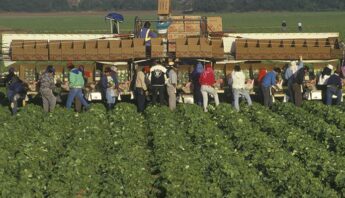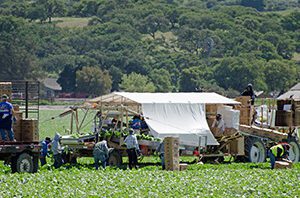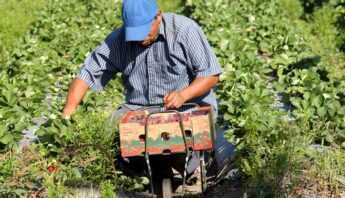Last week a Georgia business journal reported that the Georgia Farm Bureau, on behalf of state farmers, opposed EPA’s proposed rules to improve on-the-job protections for farmworkers. Their reasoning? They say a stronger Worker Protection Standard (WPS) would be detrimental to farmers and without “real benefit to anyone.”
Why would a Farm Bureau organization, claiming to support growers’ interests, lobby to undermine the health and safety of their workers? After all, laws that help keep workers safer, healthier and on the job are good for business. And they're good for our entire food system.
Improvements to EPA's safety laws are long overdue and designed to give farmworkers at least some of the protections afforded other workers. Commonsense revisions currently under consideration include:
- Increased mandatory training from every five years to every year;
- Enforced no-entry buffer areas surrounding pesticide-treated fields (in response to well-documented risks of worker exposure to pesticide drift);
- Prohibiting children under 16 from handling hazardous pesticides;
- Implementing measures to improve states’ ability to enforce compliance, including requiring employers to keep pesticide use and worker training records.
I know many farmers, both large-scale and small and none of them argue against the protections of the workers upon whose skill and hard work they depend.
Dangerous work
The nation’s nearly two million farmworkers represent the backbone and marrow of our agricultural economy. Performing some of the most demanding manual labor in any economic sector, farmworkers face some of the greatest on-the-job hazards — yet they remain among the least protected under U.S. laws.
Just one of the hazards farmworkers face is routine exposure to health-harming pesticides. An estimated 1.1 billion pounds of pesticides are applied to crops annually in the United States. And the federal government estimates that there are 10,000–20,000 acute pesticide poisonings among U.S. farmworkers every year — but we know that the real numbers are far worse as many, since many cases never get reported. The government also estimates that the pesticide poisoning incidence rate among U.S. farmworkers is 39 times higher than the incidence rate found in all other industries combined.
To sum it up, it's high time to strengthen on-the-job protections for farmworkers. And in addition to supporting healthy workers, their families and communities, these new rules will also strengthen the entire agricultural economy.
Current laws don't do enough
The Occupational Health and Safety Administration (OSHA) provides important protections to workers in most other sectors. And one might assume that farmworkers are also under the protection of OSHA. But they were explicitly omitted from the 1935 National Labor Relations Act, the 1938 Fair Labor Standards Act, and largely excluded from OSHA protections that followed OSHA establishment in 1970.
OSHA workplace protection topics are similar to those in EPA's Worker Protection Standard: training, communication of chemical hazards, and personal protective equipment, etc. Yet the WPS — even with the proposed improvements — continues to fall short.
In addition to those improvements mentioned above, here are some of the ways in which EPA could improve protections for farmworkers even further — and achieve parity between farming and other sectors:
- Set the child labor laws at the minimum age of 18 for high hazard work, rather than the WPS proposal of 16. Several states already prohibit minors under 18 from handling pesticides.
- Comply with the OSHA requirement for non-agricultural settings and require the use of closed systems for the mixing and loading of the most hazardous pesticides; California already does this, but it should be federal policy.
- In the event of a pesticide exposure incident, with reasonable grounds to suspect a resulting acute pesticide illness, require immediate transportation of the employee to a health care facility. The WPS proposes to allow a thirty minute delay.
- Align WPS with OSHA’s Hazard Communication Standard providing stronger protections in all areas, rather than just a few.
- Effectively inform employees, as dictated by OSHA, about hazardous chemicals in the workplace. EPA proposes to remove the equivalent central posting requirement.
- Require worker training before going into the fields (or in a workplace with hazardous chemicals), not days later as EPA proposes. This is an OSHA policy, and already in place for farmworkers in California and Washington.
- Require pesticide use records to be kept beyond the two years proposed by EPA.
Movement in the right direction
While there is more work to do, the currently proposed Workplace Protection Standards are an improvement on what's been in place for years. EPA is currently reviewing strengthened versions of the rules, and we're helping to keep pressure on the agency to do the right thing.
As you’ve seen in our blogs, alerts, and press work, we successfully helped generate more than 200,000 comments, during EPA's open period for public input, in support of a strong WPS — one even stronger than what's currently on the table. But with responses like that from the Georgia Farm Bureau, we know EPA is also facing strong pressure from industry to keep the rules weak.
Still, EPA Administrator Gina McCarthy has signaled that she's committed to doing the best job she can. Her staff sat down with farmworkers who traveled across the country to tell their stories and urge the agency to provide them with the workplace protections they deserve. And the agency has also met repeatedly over the years with PAN, other farmworker advocates and farmworkers to hear our concerns and consider the evidence we’ve repeatedly provided.
And you, our supporters and allies, have stepped up to the plate — many times — to echo our concerns and demands. Please take a moment now to thank Administrator McCarthy for her leadership — and to let her know we will continue to urge EPA to enact a revised WPS that offers the best protections possible, protections that other workers already receive and that farmworkers deserve as well.








